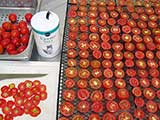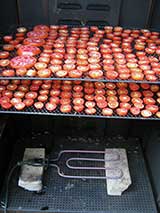Meats and Sausages
Drying Food
Drying food is one of the oldest methods of food preservation. It may be used alone,or in a combination with other preservation methods, for example salting, smoking or fermenting.
The reason food spoils is that it is invaded by bacteria. Bacteria like all other living creatures need food and water. Majority of bacteria thrive in warm conditions, from 60-140° F (15-60° C) in the so called “danger zone.” They are lethargic at low temperatures and active at high ones, but they desperately need water. Not to drink, as they have no mouth, but to dissolve foods in water, which they can then absorb through their skin.
If they are given dry food, for example dried peas or dry milk, they are not able to eat them, however when peas are soaked in water, or humidity levels increase to such an extent that there is plenty of moisture in air, they will be able to absorb food. Then, they will grow, the right term is multiply, as they divide in numbers of the same size. They excrete waste like any living organisms, and this waste becomelarger and larger and the food starts to smell. We simply say that the food is spoiled.
If we deprive bacteria of water, they cannot grow, they cannot excrete the waste and the food will not spoil. This is exactly what “drying” is; removing sufficiently large amount of moisture from food, so that bacteria will not be able to eat. In technical terms the amount of water that is available to microorganisms is defined as water activity (Aw). Some water is tightly bound in food and bacteria cannot access it, however, there is plenty of “free” water. Aw does not specify how much water is in food, but how much water is available to support the growth of microorganisms. Below certain Aw levels, microbes cannot grow. USDA guidelines state: "A potentially hazardous food does not include... a food with a water activity value of 0.85 or less."
Water activity is covered in more detail at:
It is obvious, that certain time is needed until we reach the point when there is so little moisture that bacteria cannot absorb food. If drying proceeds slow, then they will grow in sufficient numbers to spoil food, before enough moisture is removed to inhibit their growth. We have to outmaneuver them, we have to tip the scale on our side, we have to get ourselves the jump start. This is usually obtained by salting.
Drying is a slow process and applying salt offers two benefits:
- An immediate moisture removal.
- Inhibiting the growth of spoilage bacteria.
We may add 1.5% salt to a fresh or smoked sausage as both products will be cooked before serving. Such a product is not being preserved and salt is added for flavor and not to preserve the sausage. On the other hand we have to add 3% salt to traditionally dried salami to slow down the growth of spoilage bacteria until enough moisture is removed from the sausage. In this case, salt is added not to flavor the product, but to help in drying process. Drying is the method that will make salami safe and stable.
Salt draws moisture from any food it gets in contact with. Before advent of refrigeration, fish was preserved by heavy salting. Salt removed water; the water was drained away and more salt was applied. Then fish was packed in wooden barrels and caravans delivered fish to landlocked areas. Although such fish had to be soaked for a few days in water before cooking, nevertheless the nutrients and flavor were preserved.
Vegetables when dried in open air will benefit greatly from being sprinkled with salt on their surfaces. This immediately draws moisture out and shortens the process.
Drying food is influenced by:
- Humidity - higher humidity, slower drying
- Temperature - higher temperature, faster drying
- Air flow - faster air speed, faster removal of moisture
Understanding drying is crucial when making slow fermented, cold smoked or air dried products as the technology of manufacturing these products depends mainly on drying.
Drying and Smoking Food
Food can be dried and smoked at the same time, for example drying jerky in a smokehouse, at 140° F (60° C). It must be noted that for making air dried (uncooked) sausages smoke temperature should correspond to the temperature in a drying chamber and that will require application of cold smoke. It should be noted that smoking is not a preservation method, it is an additional safety hurdle which when backed by drying or increasing acidity (pH drop) will contribute positively to the safety of the meat.
Drying process should be balanced. The equilibrium state: diffusion rate = evaporation rate. For example the sausages are drying from inside out and the moisture removed from the surface should be replaced by the moisture coming from the inside of the sausage.
Ventilation
Good ventilation is crucial to the drying process as it removes the moisture from thesurface of the food and from the drying chamber. If moisture were not removed from the chamber, humidity will increase, drying will slow and molds will appear.Ventilation is hardly a problem when the food is dried in open air or in a smokehouse where the draft removes moisture with smoke. In smaller units such ashome dehydrator an inside fan circulates and removes the moisture laden air.
More about drying.



















